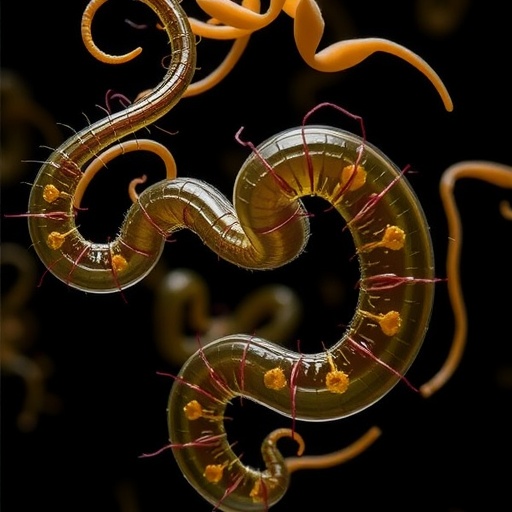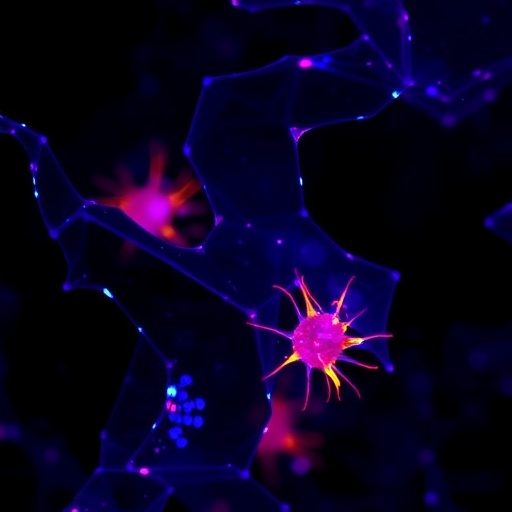
In a groundbreaking study, researchers Li, Zhao, and Xu delve into the intricate world of Strongyloidea nematodes, revealing critical insights into their evolutionary mechanisms through comparative mitogenomics. This research aims to elucidate the complex dynamics between these parasites and their hosts that inhabit the gastrointestinal tract. By employing advanced genomics techniques and evolutionary analysis, the study not only widens the scientific understanding of nematodes but also underscores implications for ecological health and pathogen management.
The Strongyloidea superfamily consists of a group of parasitic nematodes that primarily target the gastrointestinal tracts of various vertebrate hosts, including humans, livestock, and wildlife. With their extensive evolutionary history, these organisms exhibit adaptations that allow them to thrive in hostile environments, evade immune responses, and exploit available resources effectively. The research conducted by Li and colleagues embarks on a comprehensive analysis of their mitochondrial genomes, laying bare the evolutionary strategies employed by these parasites.
The study begins by establishing the foundational role that mitochondrial genetic material plays in understanding the evolutionary trajectories of Strongyloidea. Mitochondrial DNA is particularly valuable because it is inherited maternally and evolves at a relatively higher rate compared to nuclear DNA. This feature allows researchers to trace back lineages and comprehend diversification pathways among nematodes. The authors present a robust methodology that integrates sequencing technology with computational phylogenetics to analyze the complete mitochondrial genomes of various Strongyloidea species.
One of the notable findings from this comparative mitogenomic analysis is the identification of distinct evolutionary drivers that are unique to Strongyloidea. The researchers uncovered various gene rearrangements and variations in genome size that suggest adaptive evolution in response to diverse ecological niches. These findings provide clarity on how environmental pressures can shape the genetic landscape of parasitic nematodes. Furthermore, the study illustrates the relationship between these genomic alterations and the evolutionary fitness of these parasites in their specific host environments.
The relevance of this research extends beyond genetic curiosity. Understanding the evolutionary drivers of Strongyloidea nematodes can inform strategies for managing infections in both agricultural and clinical settings. As these parasites are responsible for significant health burdens, particularly in developing countries, insights from this study may contribute to the development of targeted treatment methods and preventive measures. Additionally, the authors highlight the need for continued research into the host-parasite interactions that influence nematode success.
In the context of evolutionary biology, this study serves as an exemplar of the fusion between genomic technologies and ecological research. By providing a detailed genomic framework for Strongyloidea, the research emphasizes the importance of interdisciplinary approaches in solving complex biological challenges. The implications of these findings could resonate throughout various fields, including veterinary science, medicine, and environmental biology.
Researchers have long been intrigued by the evolutionary strategies employed by parasitic organisms. The methodologies used in this investigation offer a template for future studies aimed at dissecting the genetic intricacies of other parasitic taxa. Li and colleagues’ work exemplifies the potential for mitogenomic analyses to serve as a foundational tool for unraveling evolutionary mysteries within a plethora of organisms.
As nematodes continue to adapt to their environments, the genetic adaptability observed in Strongyloidea raises important questions about ecological resilience and the sustainability of host species. The ongoing evolution of these parasites can present unforeseen consequences, thereby necessitating a deeper understanding of their biology. As the science community processes the findings of this study, the conversation around parasite management and ecological health will undoubtedly grow in importance.
Furthermore, this work lays the groundwork for future explorations of host defenses and the co-evolutionary dynamics between Strongyloidea nematodes and their hosts. Investigating these interactions could lead to surprising revelations about how hosts adapt their immune responses in the face of persistent parasitic threats, adding another layer of complexity to the narrative of life that includes both parasites and their hosts.
In addition to its direct contributions to the field of parasitology, the findings also have broader implications for the study of evolutionary biology and genetics. They challenge researchers to consider the ways in which environmental factors influence genetic variation and drive evolutionary change across diverse species. As the methodologies become more refined, the potential to uncover patterns of evolution previously obscured by traditional study methods grows exponentially.
As audiences turn their attention to these findings, the importance of communicating science to the public increases. The health implications tied to the study of parasitic infections are profound, and bridging the gap between research and societal understanding will be pivotal in addressing public health challenges. The dialogue surrounding the evolutionary mechanisms of Strongyloidea not only enhances academic pursuits but also reflects broader societal issues in health management.
In summary, the comparative mitogenomics research conducted by Li, Zhao, and Xu provides novel insights into the evolutionary drivers of Strongyloidea nematodes and their ecological dynamics. The implications of this work extend into numerous spheres, including public health and environmental conservation. As we continue to unravel the complexities of these parasites, continued cross-disciplinary collaboration will be essential in tackling the challenges they present.
Through this study, the narrative of Strongyloidea nematodes is transformed from mere biological curiosity to a significant force within ecological and health discussions. The evolutionary mechanisms that empower these parasites to thrive in gastrointestinal tracts are now being more clearly understood, providing a stepping stone for future inquiries into the resilience and adaptability of life forms in an ever-changing world.
This research signifies not just a milestone in our understanding of a specific group of nematodes, but also provides a framework for an extensive exploration into the foundations of evolutionary biology. As the scientific community reflects on these findings, the call for a continued investigation into the life histories and relationships of parasites and their hosts will remain resonant and vital.
Subject of Research: Evolutionary drivers of Strongyloidea nematodes through mitogenomics.
Article Title: Comparative mitogenomics reveals evolutionary drivers of Strongyloidea nematodes dwelling in gastrointestinal tract.
Article References:
Li, J., Zhao, X., Xu, P. et al. Comparative mitogenomics reveals evolutionary drivers of Strongyloidea nematodes dwelling in gastrointestinal tract. BMC Genomics 26, 793 (2025). https://doi.org/10.1186/s12864-025-11980-5
Image Credits: AI Generated
DOI: 10.1186/s12864-025-11980-5
Keywords: nematodes, Strongyloidea, mitogenomics, evolutionary biology, parasites, gastrointestinal tract, ecological health, host-parasite interactions, genomics, adaptive evolution.
Tags: adaptations of gastrointestinal nematodesadvanced genomics in parasitologycomparative mitogenomics in nematodesecological health and nematodesevolutionary history of Strongyloideaevolutionary strategies of Strongyloideagastrointestinal parasites researchhost-parasite dynamics in nematodesmaternal inheritance in mitochondrial geneticsmitochondrial DNA analysis in parasitespathogen management in parasitic infectionsStrongyloidea nematodes evolution




